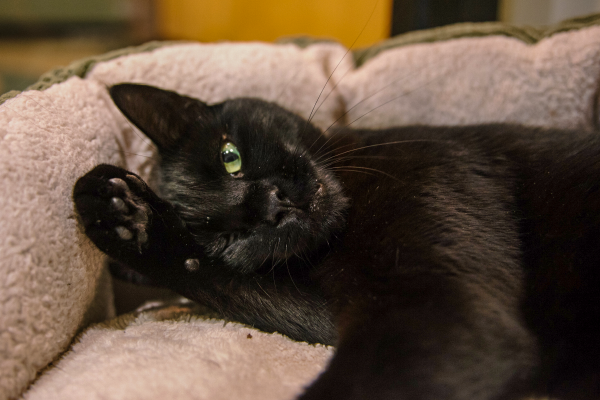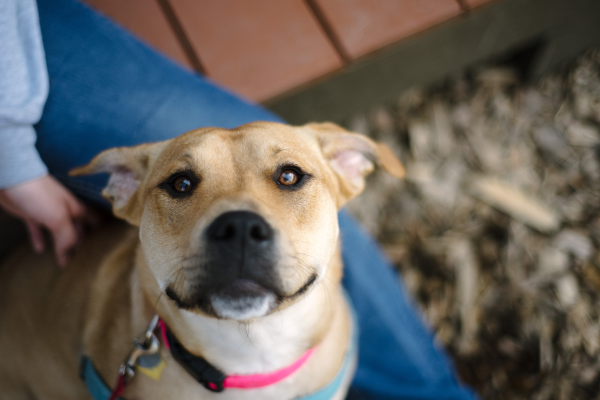The pandemic has taken a toll on our mental health, and our pets may be feeling it too.
Advice from Jennifer Shirley, CPDT, OHS Training and Behavior Department
Over the last eight to nine months, people have had to make substantial changes in their lives, deal with painful isolation, unexpected moves and many have lost jobs, taken cuts in pay and are now struggling financially. And countless parents are balancing their work life and managing their kids’ virtual school-in-the-kitchen. This is hard on everyone, including our pets.
Animals acclimate to our routines and how we move through our lives. They instinctively attend to our emotional temperature. They know what’s normal for us. They even know which room we spend most of our time and when we’re under the covers more than usual. They are paying attention to the most nuanced changes. Our stressors become our animals’ stressors, to one degree or another.
More time at home and new living situations during COVID-19
I’ve talked to several pet owners who have needed to rent out a bedroom in their house or apartment in order to make ends meet or have moved back home with parents. Some pets can easily acclimate to living with additional people, while the timid cats and dogs, for example, might be more on edge having to suddenly share their space with unfamiliar people suddenly. It can drastically change the dynamics of the home environment for the pets, making it feel less safe or too chaotic and this can result in behavior changes.
One part of the shift to working from home that I’ve been worried about is, what happens when people stop working from home? This has been a problem for a lot of people who worked from home in the spring for several months, then went back into their offices only to be asked to return home to work again. Our animals thrive when their lives include a predictable routine. Unpredictability creates confusion for some pets while others can begin showing signs of anxiety, for example nonstop barking or loss of bowel/bladder and/or destructive behavior when alone. This seems to be more of a problem for pets who live with a single person versus pets who live with a family where the dog or cat has multiple, familiar people to depend on.
Preparing your pet for the future
Even if you’re working from home, make sure to leave your dog alone for brief periods of time so he becomes accustom to being alone at times. Leave him with a Kong, stuffed with something yummy, for 10-15 minutes at first to see how he does. Until you know how he’ll do in your house alone, close doors so he has a smaller area to himself.
Anxiety in cats
I got my first ever call on the Behavior Helpline about a cat with “separation anxiety” about a month ago. I knew that cats could show signs of this type of anxiety but had never dealt with it before this person called the helpline. The cat meowed nonstop if the person even left the room to go take a shower and would stop as soon as the person came back into view. In this case, the person had just adopted the cat. The cat just needed time to settle in and acclimate to the new home and learn the new routine.
Cats can show signs of upset or anxiety when not being able to do cat-like behaviors. If they’re used to having supervised time outside but that stops or if they’re alone too much. This can be a problem for cats who live with a single person who is gone a lot, for whatever reason, or in a home with little mental or physical stimulation for the cat, e.g. no ability to climb, no access to windows, few comfy resting spots, uninteresting toys, etc.
Cats can start to eliminate outside of the litter box, begin scratching in new places, usually on furniture, and some can even become aggressive.

Anxiety in dogs
Dogs can show anxiety in multiple ways; barking, pacing, unable to settle, loss of bowels/bladder, reactivity to other dogs and/or people and some dogs can develop OCD-like behaviors if anxiety-provoking triggers persist over time. Some newly adopted dogs simply need time to settle into their new homes slowly to avoid becoming anxious. It’s exciting to bring a new dog home, but I’ve spoken to many well-intentioned people who do way too much, right away, with their dogs. Sometimes less is more.
Reducing anxiety
Use your fenced backyard for potty breaks and playtime instead of showing your new dog your entire neighborhood. Or if you must go on a walk, circle the same two blocks so your dog becomes very familiar and comfortable with a small part of your neighborhood. What can appear to be an ill-mannered dog you’ve just adopted may just be a very anxious dog who is totally overwhelmed with what’s being presented to him at once. Slow down, develop a predictable routine, keep life simple at first and get to know each other.
Calls to the Behavior Help Line reflect changing patterns in our lives
During these last eight months I’ve heard from a lot of people who already had multiple pets and kids, and decided to adopt one more dog, a new kitten or a puppy and things are going badly. Or a new roommate moved in with his resource-guarding Husky who keeps attacking the resident pets sending them to Dove Lewis. Several people called because their dogs have developed “separation anxiety.” The owners haven’t left their dogs alone for almost a year.
Need help with your pets? Learn more about our Behavior Help Line.
What can pet owners do to calm their pet (and maybe calm themselves in the process)?
We all know that increasing daily exercise is an excellent way to lower our stress level or anxiety, and the same is true for our pets. Exposing your dog to multiple enticing smells along a hiking trail can be very rewarding, and all that sniffing lowers his heart rate too. The combination of deeply breathing in all that fresh air and getting those muscles firing can help to lower anxiety too.
What if we don’t have enough time for a hike? Then it might be a great time for a DIY flirt pole to exercise your dog. This is a toy you can easily buy, but you can also very easily and inexpensively make one yourself with PVC pipe, a rope and your dog’s favorite toy tied to the end. Much like a cat wand toy, you can drag it on the ground for your dog to chase and grab. This also gives you an opportunity to practice “drop it” when you need your dog to release the toy.
Using a wand toy to play with your cat is a great way to exercise her. Two favorites are the Cat Dancer and Da Bird. Be sure to hide these away when not in use or most cats won’t be able to resist them. Another variation using the same toy is to place a sheet on the floor and move the wand toy around underneath the sheet for your cat to follow and swoop in on.
Sometimes pets may appear to be enthusiastic and energized, but the truth might be quite different. Your dog might be unable to settle because of anxiety. What they need more than anything is an opportunity to feel safe enough to relax and sleep. Cats who may frequently pace and meow might just be looking for the right resting spot, tucked in a nook, where they can feel tucked away enough to sleep. Puppies are great at masking their exhaustion as energy, until they begin to spin out of control with a nipping frenzy. Never underestimate the value of a good old-fashioned nap, for both of you.








